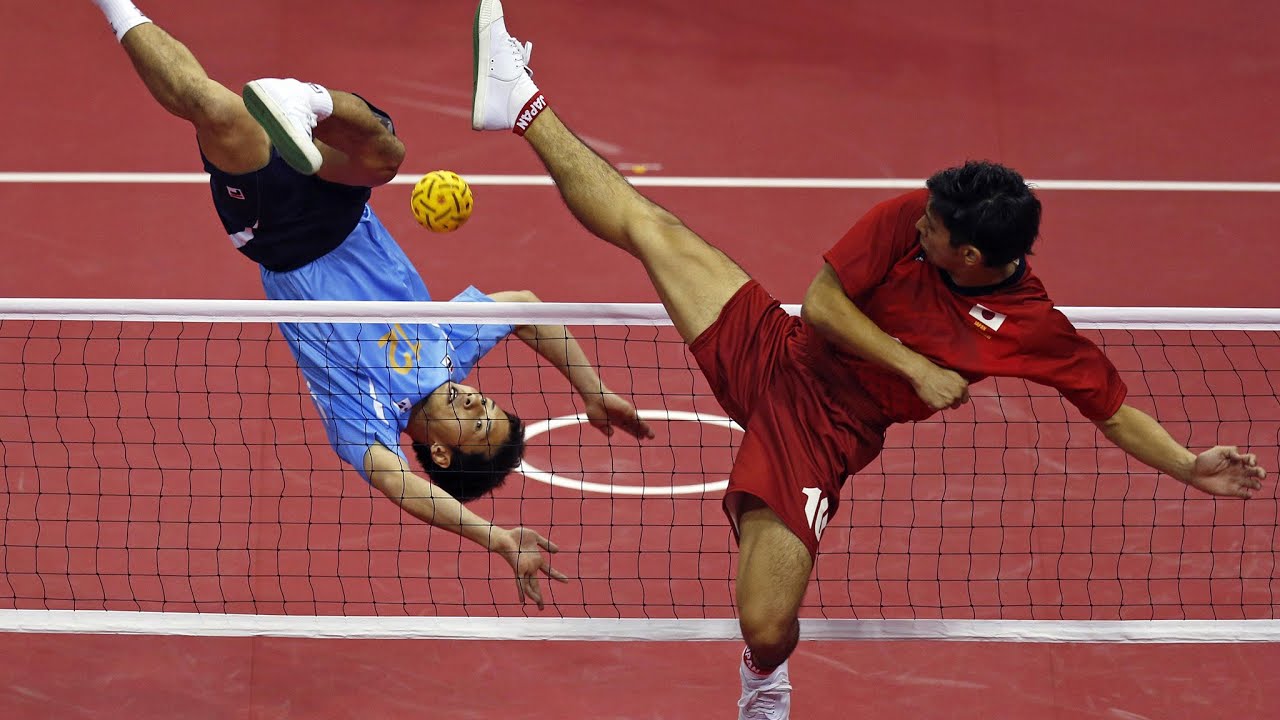
Sepak Takraw, a dynamic and fast-paced sport originating in Southeast Asia, combines elements of volleyball and soccer with unique rules and playing style. Teams of three players each strive to score points by using any part of their body except their hands and arms to send a rattan ball over a net into the opposing team’s court. This demanding game requires extraordinary agility, acrobatics, and precision, with players executing breathtaking aerial maneuvers, like bicycle kicks, to secure points. Beyond its athletic prowess, Sepak Takraw holds deep cultural and historical significance in Southeast Asia, representing a cherished part of the region’s heritage. It has also gained international popularity, featuring in competitions and world championships while captivating a growing global fanbase with its display of athleticism, skill, and teamwork.
Here are some interesting facts about Sepak Takraw:
Sepak Takraw has its roots in Southeast Asia, and its history can be traced back over 500 years. The game’s name is derived from two Malay words: “Sepak,” which means “kick,” and “Takraw,” which means “woven ball.” It was initially played informally with a rattan ball, which is still used today.
Sepak Takraw is most popular in Southeast Asia, where it enjoys a massive following. Thailand, in particular, has a strong tradition of excellence in the sport, often dominating international competitions.
The Sepak Takraw ball is a key component of the game. It’s typically made from rattan strips woven together to form a spherical shape. These rattan balls are incredibly lightweight, making them ideal for the sport’s acrobatic plays.
A standard Sepak Takraw court is 13.4 meters long and 6.1 meters wide, with a net running across the width at the center. The court size ensures that players have ample space to perform aerial acrobatics and make precise kicks.
A team in Sepak Takraw consists of three players on each side, totaling six players on the court during a match. This smaller team size allows for more dynamic and fast-paced gameplay.
Traditionally, Sepak Takraw used a scoring system where the first team to reach 21 points won a set. However, many modern competitions now use a rally point system, where every rally results in a point being awarded, regardless of which team served.
The game begins with a serve, where one player from the serving team kicks the ball diagonally over the net to the opposing team’s court. This is similar to how a volleyball match starts.
In the men’s game, the net is usually set at a height of approximately 5 feet 1 inch (1.55 meters), while in the women’s game, it’s set slightly lower at around 4 feet 11 inches (1.50 meters). The height difference adds an extra challenge for female players.
In a standard match, teams play two sets, with the first team to reach 21 points winning each set. However, if the match is tied at 1-1 in sets, a third set, often called a “Tiebreak,” may be played to 15 points to determine the winner.
Sepak Takraw is often described as a fusion of volleyball and soccer. It shares similarities with volleyball, such as the use of a net and the scoring system, but players use their feet, head, knees, and chest to hit the ball over the net, similar to soccer, making it a unique and captivating sport.
Sepak Takraw is not just a sport; it’s deeply intertwined with the cultural fabric of many Southeast Asian communities. It is often played during festivals, celebrations, and gatherings, making it a symbol of cultural identity and pride.
The Sepak Takraw World Championships have been held since 1965 for men and 1982 for women. These prestigious tournaments gather the best players from around the world to compete for the title of world champion.
Sepak Takraw is a prominent sport at the Asian Games, one of the most significant multi-sport events in Asia. Both men’s and women’s Sepak Takraw events are featured, and the competition is fierce among Asian nations.
In addition to the traditional three-a-side format, Sepak Takraw also has a variation called “Double Regu.” In this version, teams consist of only two players on each side, creating a more compact and intense game.
One of the most spectacular and awe-inspiring moves in Sepak Takraw is the bicycle kick, where players use their legs to strike the ball while in mid-air. This acrobatic maneuver requires exceptional coordination and timing.
Sepak Takraw courts are typically constructed from wood or synthetic materials like rubber or PVC. The choice of materials ensures a consistent and resilient playing surface.
The sport is governed globally by the International Sepaktakraw Federation (ISTAF). ISTAF plays a crucial role in establishing and enforcing rules, organizing international competitions, and promoting Sepak Takraw worldwide.
Players typically wear sleeveless shirts, shorts, and sports shoes. The colors of the uniforms may vary by team, but they are designed to allow for ease of movement and agility during play.
Sepak Takraw players employ various serving styles, each with its own strategy and level of complexity. Some common serves include the “inside foot,” “outside foot,” and “roll-over” serve, each designed to catch opponents off guard.
Sepak Takraw players are renowned for their incredible juggling skills. They can control the ball with remarkable precision using their feet, head, knees, chest, and even shoulders. These skills are essential for maintaining ball possession and launching accurate attacks.
Asian countries have historically dominated Sepak Takraw competitions. Nations like Thailand, Malaysia, Indonesia, and the Philippines consistently perform well at international events. Thailand, in particular, is often regarded as the strongest nation in the sport.
Thailand’s dominance in Sepak Takraw is exemplified by its numerous gold medals at international tournaments, including the Asian Games and World Championships. The country has invested heavily in the sport, with a robust infrastructure and development programs.
Sepak Takraw has made inroads beyond Southeast Asia and has gained popularity in other regions, particularly in parts of Europe, North America, and the Middle East. Enthusiasts and clubs in these regions actively promote and play the sport.
Some countries, notably Thailand, have established professional Sepak Takraw leagues. These leagues provide a platform for elite players to compete at the highest level and earn a living from the sport.
While the standard Sepak Takraw rules are widely followed, there are different regional variations of the game. These variations may have unique rules or adaptations to suit local preferences, showcasing the sport’s flexibility and adaptability to different cultures.
Sepak Takraw FAQs
1. What is Sepak Takraw?
Sepak Takraw, also known as kick volleyball, is a dynamic sport that combines elements of volleyball, soccer, and martial arts. Players use their feet, knees, chest, and head (except for hands and forearms) to control a rattan or synthetic ball over a net. It’s a fast-paced and highly acrobatic sport requiring agility, flexibility, and teamwork.
2. Where did Sepak Takraw originate?
Sepak Takraw is believed to have originated in Southeast Asia, with evidence suggesting it was played in the Malay Peninsula (present-day Malaysia) as early as the 15th century. It was enjoyed in royal courts and has spread throughout Southeast Asia, gaining popularity in countries like Thailand, Vietnam, Laos, and the Philippines.
3. How many players are on a Sepak Takraw team?
A Sepak Takraw team, called a “Regu,” consists of three players on the court at a time, with up to two substitutes. Each player has a specific role:
- Tekong (Server): The player in the center responsible for initiating rallies with a serve.
- Left Inside (Feeder): Controls the ball flow, sets for the attacker, and can also spike.
- Right Inside (Attacker): Focuses on spiking the ball to score points.
4. How is Sepak Takraw played?
The game is played on a rectangular court similar to badminton, with a net in the middle. Teams take turns controlling the ball using only their feet, knees, chest, and head for a maximum of three touches per team before sending it over the net. Points are scored when the opposing team fails to return the ball properly, commits a fault, or the ball lands out of bounds. Matches are typically played to the best of three sets, with each set reaching 21 points (extended to 25 points if tied at 20-20).
5. What are some of the key skills required for Sepak Takraw?
- Agility and Reflexes: Players need to react quickly to the fast-paced nature of the game and control the ball with precision.
- Flexibility: High kicks, volleys, and acrobatic maneuvers require a good range of motion.
- Balance: Maintaining balance while controlling the ball with different body parts is crucial.
- Teamwork: Communication and coordination are essential for setting each other up for successful attacks.
6. Is Sepak Takraw popular internationally?
Sepak Takraw is a major sport in Southeast Asia and is gaining recognition worldwide. It’s a featured sport in the Southeast Asian Games and is also included in international competitions like the King’s Cup World Championship. The International Sepak Takraw Federation (ISTAF) governs the sport internationally and promotes its development around the globe.
7. Where can I learn more about Sepak Takraw?
There are many resources available online and in libraries to learn more about Sepak Takraw. You can find information on the rules, gameplay, history, and even instructional videos to help you understand the sport better. Additionally, national Sepak Takraw federations in your country might offer resources or even opportunities to try the sport yourself.








